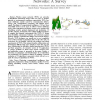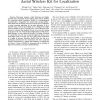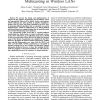5649 search results - page 131 / 1130 » Wireless Communication Is in APX |
135
click to vote
INFOCOM
2011
IEEE
14 years 1 months ago
2011
IEEE
—For energy conservation, a wireless sensor network is usually designed to work in a low-duty-cycle mode, in which a sensor node keeps active for a small percentage of time durin...
110
click to vote
COMSUR
2011
13 years 9 months ago
2011
—Wireless sensor networks (WSNs) are networks of distributed autonomous devices that can sense or monitor physical or environmental conditions cooperatively. WSNs face many chall...
INFOCOM
2012
IEEE
13 years 12 days ago
2012
IEEE
—This paper presents a fully functional and highly portable mini Unmanned Aerial Vehicle (UAV) system, HAWK, for conducting aerial localization. HAWK is a programmable mini helic...
INFOCOM
2012
IEEE
13 years 12 days ago
2012
IEEE
—We present the design and implementation of ADAM, the first adaptive beamforming based multicast system and experimental framework for indoor wireless environments. ADAM addres...
116
click to vote
INFOCOM
2012
IEEE
13 years 12 days ago
2012
IEEE
—Sensor deployment is a fundamental issue in a wireless sensor network, which often dictates the overall network performance. Previous studies on sensor deployment mainly focused...



